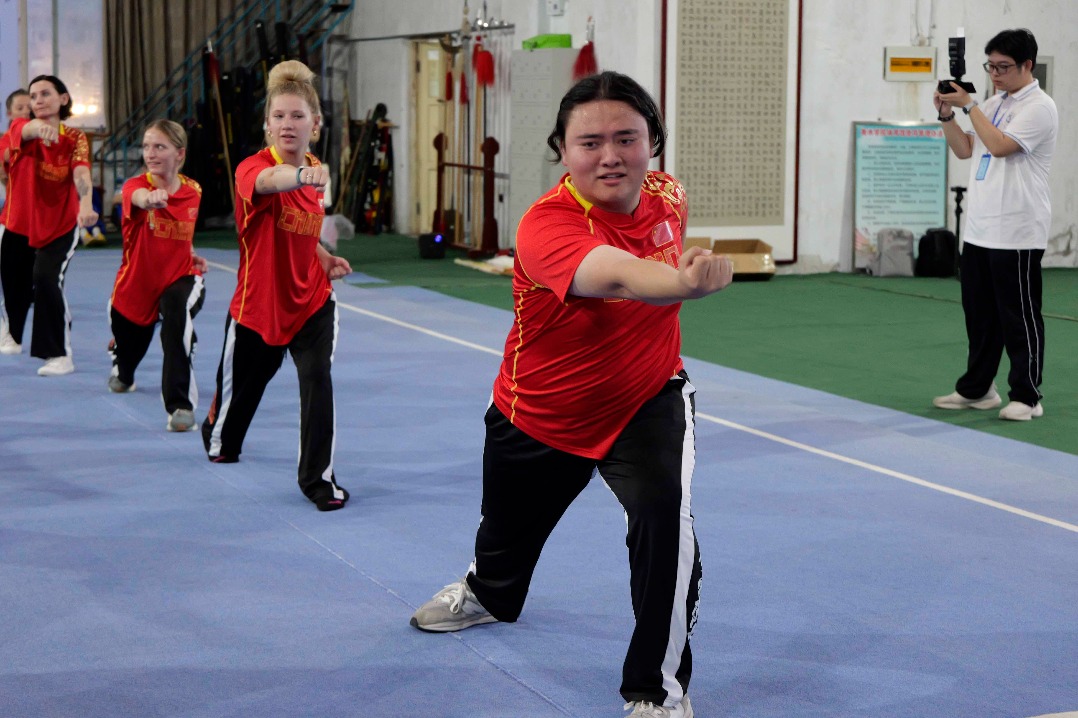China's BMI tech reaches new heights
Miniaturized, wireless system offers hope for people with motor disabilities

A collaborative effort between scientists, doctors and an enterprise led to China successfully conducting its first-in-human clinical trial of an invasive brain-machine interface, becoming the second country in the world, following the United States, to make the advancement in BMI technology.
The trial participant is a male who became a quadruple amputee after losing his limbs in a high-voltage electrical accident 13 years ago at the age of 24. Since the implantation of the BMI device in March, the system has been running smoothly without any infections or electrode failures. Within three weeks of training, he was able to play Chinese chess and racing games on the computer using his mind, achieving a level of control comparable to using a laptop's touchpad.
The team of researchers from the Chinese Academy of Sciences' Center for Excellence in Brain Science and Intelligence Technology and the Huashan Hospital of Fudan University, said after receiving regulatory approval for the system in the future, it may offer a potential breakthrough in improving the quality of life for millions of individuals with complete spinal cord injuries, bilateral upper limb amputations, and amyotrophic lateral sclerosis through motor function replacement technology.
"I'm so excited that I can be able to play digital games with my family, getting more involved in family life. In the future, perhaps I can control a mechanical arm with my thoughts and get objects at will. I'm so looking forward to that day," said the trial participant in a video message provided by the CAS center.
Poo Muming, an academician with CAS and scientific director of academics at the CAS center, said that the miniaturization and wireless capabilities of the technology provide a foundation for its future widespread clinical use.
"The research progress is proceeding smoothly, with plans to launch the second clinical trial soon," said Poo.
While Neuralink, owned by tech billionaire Elon Musk, initiated its work on BMI systems five years ago and currently presents as industry leader, Poo said their team, which only began three years later, has obtained a leading position when it comes to neural interface technology and achieves control levels similar to Neuralink.
Zhao Zhengtuo, a lead researcher on the team, said, "The neural electrodes developed and produced by our team are currently the finest and most flexible globally, with a cross-sectional area less than one-fifth of those used by Neuralink and flexibility exceeding Neuralink's by a hundredfold."
Furthermore, the domestically developed invasive BMI system can steadily collect single-neuron spike signals for an extended period, and its millisecond, single-neuron level neural signal capture characteristics provide a solid data foundation for applications in neural electrical signals, said the researchers.
"In terms of surgical friendliness, the implant developed by the CAS center has a diameter of 26 millimeters and a thickness of less than 6 mm, making it the world's smallest brain-controlled implant, just the size of a coin and half the size of Neuralink's products," said Zhao.
Therefore, the implantation does not require the full penetration of the skull, but only a coin-sized groove in the skull above the motor cortex in order for the device to be embedded.
During the surgery, a team led by Lu Junfeng, another scientist on the research team and a doctor of neurosurgery at Huashan Hospital in Shanghai, utilized a high-precision navigation system to implant the ultra-flexible electrodes into the designated area of the trial participant's brain motor cortex. This ensured surgical precision at the millimeter level for maximum safety and effectiveness.
"Using minimally invasive neurosurgical techniques, the standardized operating procedures are conducive to the large-scale application of the technology to be realized at medical institutions at all levels in the future," Lu said.
Experts explained that real-time online decoding is a critical aspect of BMI technology, as the system must complete the entire process of feature extraction from neural signals, interpretation of motor intentions, and generation of control commands within a window of tens of milliseconds.
Zhao and his colleagues achieved dynamic optimization of neural decoders through a self-developed online learning framework. This decoding framework, combined with the stable advantage of flexible electrode signal acquisition and high-precision estimation strategies for neural firing, enables low latency, high robustness, and stable real-time motion decoding.
"For the next step of our study, we plan to let the trial participant attempt to use a mechanical arm with his mind, so that he can perform actions, such as grasping objects and holding cups, in his physical life," said Zhao.
"Future plans also include enabling the trial participant to control complex physical peripherals like robotic dogs and embodied intelligent robots, expanding the participant's boundaries of daily living," he said.
- China's BMI tech reaches new heights
- Gambian farmer pays tribute to 'father of hybrid rice'
- China enhances coastal ecosystem protection and restoration
- Jiangsu presents innovation-driven growth and economic leadership
- China Prospectors Conference calls for AI in mineral exploration
- Tsinghua, PKU condemn sale of campus lake water





































